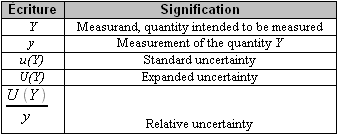
Introduction
In the optical field as in other experimental sciences, there is no such thing as an « exact measurement ». Measurements will always be subject to error, to which extent will depend on the method chosen, the operating procedure, the quality of the measuring instruments or the skills of the operator.
Evaluating the uncertainty of a measurement requires a complex method which constitutes a branch of sciences called "metrology". In order to give this evaluation with a large and universally recognized consensus, a guide has been set up for the expression of measurement uncertainties. Its French version is the NF ENV 13005 norm dated August 1999 [1]. As for the normative vocabulary, the NF X07-001 norm of December 1994 [2] contents all the International vocabulary of metrology (VIM).
Basic vocabulary
The formats and general terms of table 1 will be used throughout the lesson.

Note:
-
Do not confuse Y and y : Y designates the quantity which is the subject of a measurement, while y designates the numerical result of this measurement.
-
La notation u et U provient de l'anglais «uncertainty»
Types of measurements
The measurement of a quantity Y can be obtained:
-
either directly; for instance, when a distance X is measured with a ruler,
-
or indirectly; for instance, when a displacement L is measured by an interferometric method.
In the first case, the functional relation is simple, of type
 , if N replicate measurements of the distance
X
are performed and that we consider their average value
, if N replicate measurements of the distance
X
are performed and that we consider their average value
 .
.
In the second case, the displacement L is such as
 where p is an integer ,
where p is an integer ,
 is the wavelength in vacuum of the luminous source used in the interferometer and n(T,P,H) is the index of the medium (air for example) where light rays propagate; this index is a function of the ambient medium's temperature T , of its pressure P and of its hygrometry degree H.
is the wavelength in vacuum of the luminous source used in the interferometer and n(T,P,H) is the index of the medium (air for example) where light rays propagate; this index is a function of the ambient medium's temperature T , of its pressure P and of its hygrometry degree H.
In general, we will consider
 will be input quantities that will generally be directly measured.
will be input quantities that will generally be directly measured.